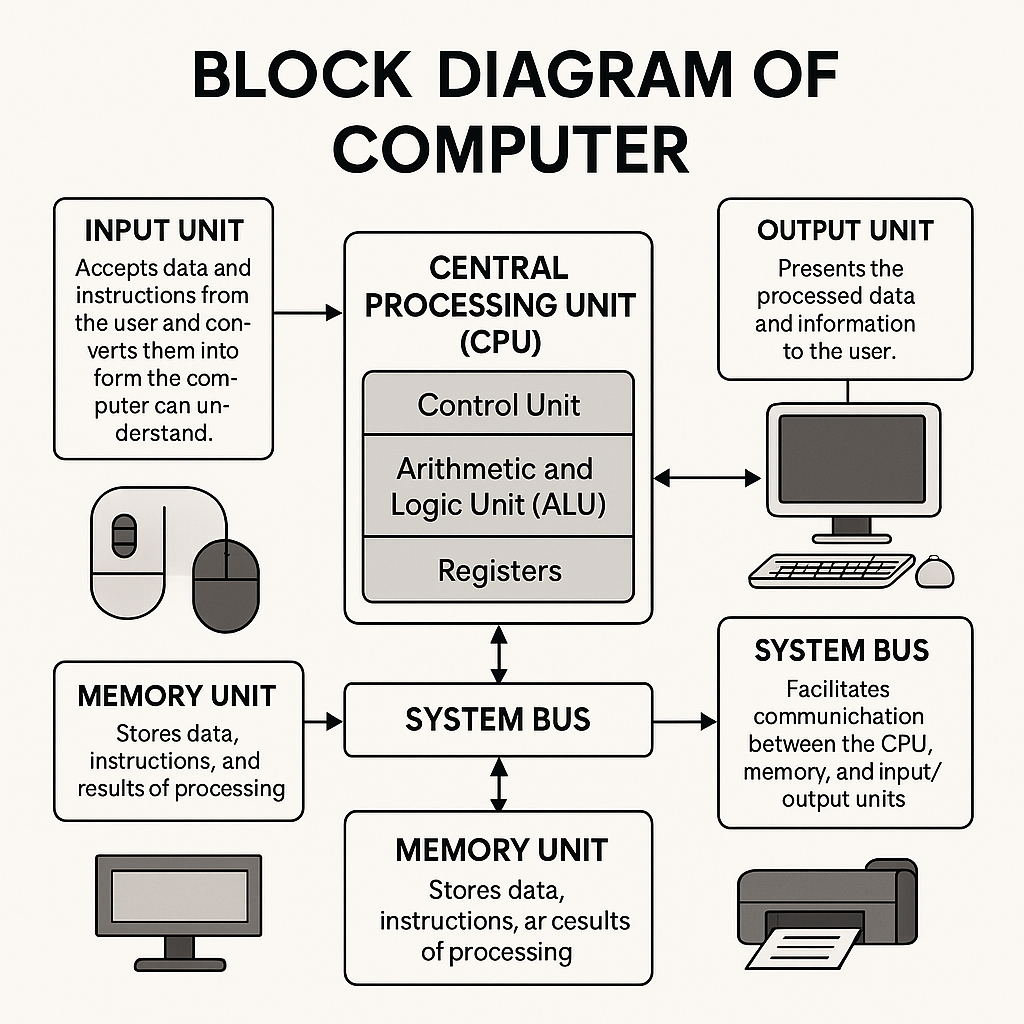










Courses

By Swati Singh
|
Updated on 22 Oct 2025, 12:04 IST
Computers have become essential in every aspect of modern life—whether for learning, business, or entertainment. To truly understand how computers work, it helps to break down their architecture into a block diagram. This diagram provides a high-level view of how information flows through different units of a computer system.
In this blog, we’ll explore the block diagram of a computer in detail, covering each component and its role.
A block diagram of a computer is a simplified representation of the major functional components of a computer system. It shows how data flows between input, processing, memory, and output units. Instead of focusing on wires or circuits, it focuses on logical operations and interactions.
The core idea: Input → Processing → Output, with memory and control units managing the process.
Also Check: Human Eye Diagram
The major components in a computer’s block diagram are Input Unit, Central Processing Unit (CPU), Memory Unit, Output Unit, and System Bus—together they manage the flow of data from user input to final output. Each plays a distinct role, ensuring smooth processing and communication within the system.

The input unit serves as the gateway between the user and the computer. Its job is to accept raw data and instructions from the user and convert them into a machine-readable format (binary).

Common input devices:
Keyboard

JEE

NEET

Foundation JEE

Foundation NEET

CBSE
Mouse
Scanner
Microphone
Key role: Without the input unit, the CPU would have no way of knowing what task to perform.

Also Check: Poster making
The CPU is often called the brain of the computer. It performs calculations, makes decisions, and ensures smooth coordination of tasks. It consists of three sub-components:
Control Unit (CU): Directs the flow of data. It interprets instructions and tells the other parts of the computer what to do.
Arithmetic and Logic Unit (ALU): Performs arithmetic operations (like addition, subtraction) and logical comparisons (such as greater than, equal to).
Registers: Small, high-speed storage areas that temporarily hold instructions, addresses, or intermediate results.
The memory unit acts like a warehouse where data and instructions are stored for quick access. It consists of:
Primary Memory: RAM (Random Access Memory): Temporary, volatile storage for currently running programs.
ROM (Read Only Memory): Permanent storage for firmware and startup instructions.
Cache Memory: High-speed storage close to the CPU that reduces access time.
Secondary Storage (external link): Hard drives, SSDs, or optical disks, which provide long-term storage.
Practical note: Faster memory means smoother performance, which is why modern computers invest heavily in advanced cache systems.
Also Check: Concave Mirror Ray Diagram
The output unit converts processed data into a form that humans can understand.
Examples include:
Monitors (visual output)
Printers (hardcopy output)
Speakers (audio output)
Projectors (large-display output)
This ensures that the results of computation are not trapped inside the machine but are accessible to the user.
The system bus acts like the nervous system of the computer. It connects the CPU, memory, and input/output units, ensuring smooth communication.
It has three major parts:
Data Bus: Transfers actual data.
Address Bus: Carries memory addresses to identify where data is stored.
Control Bus: Sends control signals to coordinate activities.
The block diagram demonstrates the logical flow:
Input Unit receives instructions and data.
CPU processes the data using the CU and ALU, assisted by registers.
Memory Unit stores temporary and permanent information during processing.
Output Unit delivers the results to the user.
This cycle repeats millions of times per second in modern systems.
Simplifies Learning: It breaks down complex computer systems into easy-to-understand parts.
Troubleshooting Aid: Technicians use block diagrams to identify which unit is failing.
Design Foundation: Engineers design new processors and architectures starting from block diagrams.
Think of a computer system as a restaurant:
Input Unit: The waiter taking your order.
CPU (CU + ALU + Registers): The chef preparing the dish.
Memory: The kitchen storage (ingredients and recipes).
Output Unit: The waiter delivering food to the customer.
System Bus: The pathways inside the restaurant connecting everything.
This analogy helps visualize how each component contributes to the whole.
The block diagram of a computer highlights six key areas: Input Unit, CPU, Memory, Output Unit, System Bus, and Flow of Information.
The CPU, with its CU, ALU, and registers, drives the entire system.
Memory bridges fast processing with long-term storage.
Inputs and outputs define interaction between humans and machines.
Understanding the block diagram of a computer is foundational for anyone studying computer science, IT, or related fields. It provides not only theoretical knowledge but also practical insights into how data is handled at every step.
By mastering this concept, you can appreciate the seamless experience modern computers provide, while also preparing yourself to dive deeper into advanced topics like operating systems, computer architecture, and data processing.
No courses found
It is a simplified representation showing the main functional units of a computer (Input, CPU, Memory, Output, System Bus) and how data flows between them.
The major components are Input Unit, CPU (Control Unit, ALU, Registers), Memory Unit, Output Unit, and System Bus.
It accepts raw data and instructions from the user and converts them into a machine-readable format.
The CPU controls all activities, performs calculations, makes logical decisions, and coordinates communication between units.
Primary Memory (RAM, ROM, Cache) is fast, directly accessible by the CPU, and mostly temporary.
Secondary Memory (Hard drives, SSDs) is slower but provides permanent storage.
It is the communication pathway that connects the CPU, memory, and input/output devices, ensuring smooth data transfer.
The sequence is Input → Processing (CPU + Memory) → Output, repeated in cycles.
It builds foundational knowledge of computer architecture, making it easier to understand advanced topics like operating systems and networking.